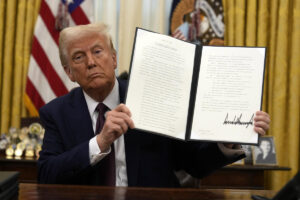The US Dollar’s Shift: What Investors Should Know
As of recent developments, the US dollar has experienced a notable decline, retreating from its near two-year highs to reach a one-month low. This fluctuation follows President Donald Trump’s recent comments in an interview where he stated he’d "rather not" impose tariffs on China. The market’s reaction was swift, causing a significant drop in the US Dollar Index (DX=F, DX-Y.NYB), which measures the currency’s strength against a basket of six foreign currencies, including the euro, Japanese yen, and British pound.
Key Drivers Behind the Dollar’s Movement
In the volatile landscape of forex trading, the performance of the dollar has primarily been influenced by two key factors:
- Political Landscape: Trump’s election and the Republican sweep have instigated changes in market sentiment, particularly regarding future economic policies.
- Federal Reserve’s Stance: The anticipation of Federal Reserve easing in response to robust economic data has also been a major influencer.
Despite this week’s turmoil, the dollar has appreciated roughly 7% since its lows in September and about 4% since Election Day. This indicates that while the dollar is experiencing short-term setbacks, the long-term trajectory appears stronger, influenced by ongoing economic recovery signs.
Tariff Policy Uncertainty
One of the most pressing concerns affecting the dollar’s trajectory is the uncertainty surrounding Trump’s tariff policies. Bank of America analysts suggest that even with a potential delay in implementing tariffs, they are likely to remain a critical component of the administration’s economic strategy. Adarsh Sinha, BofA’s lead FX strategist, noted that this uncertainty is set to persist, impacting market pricing for the dollar.
Capital Economics forecasts a further increase in the dollar index, arguing that when accounting for inflation, the dollar is at its strongest since the Plaza Accord in 1985. This strength could be driven by future shifts in tariff policy and interest rates, with MacAdam, their deputy chief global economist, asserting that the dollar’s current position could boost its value in the coming months.
Implications for US Businesses
The implications of a robust dollar extend beyond merely currency valuations. A strong dollar can adversely affect US companies, particularly those with substantial overseas revenue. As companies like Netflix have reported, a significant portion of their revenues comes from foreign currencies. For instance, Netflix indicated that around 60% of its revenue is derived from non-US dollar currencies, which, in today’s dollar-driven environment, might lead to reduced earnings growth and slower revenue forecasts.
Moreover, data from FactSet highlights that S&P 500 companies with international exposure were pivotal in driving earnings growth in the last quarter. This raises concerns about the potential for weaker earnings if currency conditions do not stabilize.
The Broader Economic Perspective
The strength of the dollar has multifaceted implications. While it typically has a short-term neutral to positive impact—given that many large firms hedge against foreign exchange risk—its long-term effects could be detrimental. An elevated dollar may reduce global trade, tighten financial conditions internationally, and negatively impact exports.
As Simon MacAdam noted, "Even if the dollar stops strengthening, a high level of the dollar can still create problems for the world economy." The interplay between currency strength and broader economic indicators cannot be overlooked, especially as the US plays a pivotal role in global trade.
Conclusion
As the situation unfolds, investors should keep a keen eye on developments surrounding the US dollar and tariff policies. The market often reacts swiftly to news in this arena, and understanding these dynamics is essential for making informed investment decisions. By staying updated on currency trends and their implications, you can better navigate the complexities of today’s financial landscape.
For more in-depth analysis and the latest updates on the stock market, look no further than Extreme Investor Network. We’re committed to providing our readers with insights that empower and inform their financial journeys.

